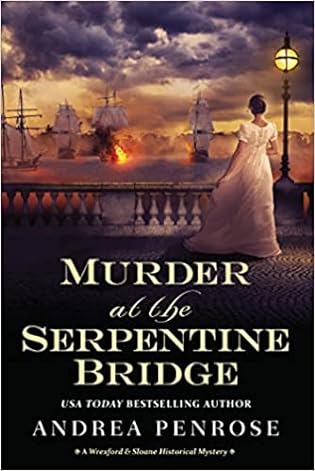 Murder at the Serpentine Bridge (Wrexford & Sloane, #6)
Murder at the Serpentine Bridge (Wrexford & Sloane, #6) by
Andrea Penrose Format: ebook Source: purchased from Amazon Formats available: hardcover, large print, paperback ebook, audiobook
Genres: historical fiction,
historical mystery Series: Wrexford & Sloane #6 Pages: 361
Published by Kensington on September 27, 2022
Purchasing Info: Author's Website,
Publisher's Website,
Amazon,
Barnes & Noble,
Kobo,
Bookshop.org,
Better World Books Goodreads Charlotte, now the Countess of Wrexford, would like nothing more than a summer of peace and quiet with her new husband and their unconventional family and friends. Still, some social obligations must be honored, especially with the grand Peace Celebrations unfolding throughout London to honor victory over Napoleon.
But when Wrexford and their two young wards, Raven and Hawk, discover a body floating in Hyde Park’s famous lake, that newfound peace looks to be at risk. The late Jeremiah Willis was the engineering genius behind a new design for a top-secret weapon, and the prototype is missing from the Royal Armory’s laboratory. Wrexford is tasked with retrieving it before it falls into the wrong hands. But there are unsettling complications to the case—including a family connection.
Soon, old secrets are tangling with new betrayals, and as Charlotte and Wrexford spin through a web of international intrigue and sumptuous parties, they must race against time to save their loved ones from harm—and keep the weapon from igniting a new war . . .
My Review:
 As the previous book in this series, Murder at the Royal Botanic Gardens, represented a door in Charlotte Sloane’s life closing, this sixth book in the series marks a different door in her life opening, albeit a door she believed she’d closed long ago.
As the previous book in this series, Murder at the Royal Botanic Gardens, represented a door in Charlotte Sloane’s life closing, this sixth book in the series marks a different door in her life opening, albeit a door she believed she’d closed long ago.
In that previous book, widowed and disgraced Charlotte Sloane married the Earl of Wrexford, removing that earlier disgrace but placing herself back in the gilded cage she ran away from more than a dozen years before.
Putting her freedom to the test and the secret of her alter ego, the muckraking political cartoonist A.J. Quill, into even greater danger of exposure – with even more uncertain consequences.
The backdrop of this particular entry in the series is a combination of a very real historical event with a plausibly realistic macguffin into just the sort of case that makes Wrexford & Sloane’s adventures so very appealing.
At first, the murder victim in the prologue would seem to have nothing to do with Charlotte or even Wrex, in spite of his discovery of the corpse. But that is seldom the case in this series. The dead man, Jeremiah Willis, was an engineer of considerable repute, working for the government on a most secret project.
The late Willis’ beloved nephew, in a case of the rather long arm of coincidence, is the ward of one of Charlotte’s newly reconciled family members. It’s clear from the very first meeting that there is something rotten in the relationship between the young Lord Lampson and his guardians, Charlotte’s sister-in-law’s older sister Louisa and her husband, a Mr. Belmont of the Foreign Office.
Charlotte’s brother-in-law (let’s call him that for simplicity’s sake) is an abusive arse. Young Lampson has inherited the title Belmont expected to inherit himself, creating plenty of room for resentment right there – particularly as it appears that the abusive arse had been running up debts in anticipation of a title that he’s not going to get after all. Adding fuel to that conflagration, Lampson is black, as was his late uncle Jeremiah.
Whatever Jeremiah Willis was working on for the British government, he’s dead, the plans for his revolutionary device are missing, and all the crowned and uncrowned heads of Europe are massing in London for a celebration of Napoleon’s defeat and exile to Elba. Creating plenty of opportunity for skullduggery at the highest levels and for the greatest stakes.
It’s a recipe for intrigue – and yet more murder. With Wrex, Charlotte, the Weasels, and their whole eccentric household caught in the middle of the imminent explosion.
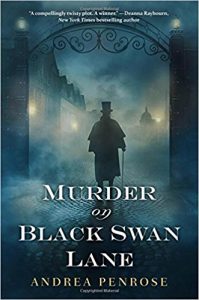 Escape Rating A: This was the right book at the right time, and I clearly waited enough time after Murder at the Royal Botanic Gardens before diving into Wrexford and Sloane’s first investigation as a married couple. Meaning that I had an absolutely terrific reading time this time around.
Escape Rating A: This was the right book at the right time, and I clearly waited enough time after Murder at the Royal Botanic Gardens before diving into Wrexford and Sloane’s first investigation as a married couple. Meaning that I had an absolutely terrific reading time this time around.
As is de rigueur for this series, the historical elements are real or at least plausibly so. Certainly the Peace Celebrations – even if we know from our future vantage point that they were just a tad premature – happened as shown in the story. The scientific and engineering discoveries at the heart of this particular mystery were indeed plausible, and the foundations were as described.
While a ‘repeating rifle’ was not invented at this particular juncture, the concepts were already circulating. The problems that remained to be solved, and eventually were, were not those of ideas or invention, but rather problems of engineering. That the industrial capabilities had not yet reached a point where the machines necessary to make the rifles a truly workable product (I hesitate to use the word ‘viable’ in this instance) were not yet themselves workable.
Obviously the engineering caught up to the concept in the years to come, but they weren’t quite there at this time. But it all makes it that much easier to get into this series and this mystery, because so many of the foundational elements don’t require the willing suspension of disbelief as they are believable in their own right.
What makes this series so fascinating to follow – as much as I enjoy the historical setting – are the people and their relationships. From the very beginning in Murder at Black Swan Lane, Wrexford and Sloane have been an unconventional couple, and the found family they have gathered around them adds to that unconventionality in the best way possible.
(The title of this entry in the series may be familiar, as it pays a bit of homage to a previously-written but historically following unconventional couple, Charlotte & Thomas Pitt, whose final adventures were published in Murder ON the Serpentine.)
A big part of what makes them special is Charlotte’s alter ego as the satirist A.J. Quill, both that she does it and how she became Quill in the first place. She stepped off the path of aristocratic respectability, broke open the bars of the gilded cage of expectations for the young women of the ton, and took the road not taken by eloping with her art teacher – only to return older, sadder, wiser, widowed and broke. So she took up her late husband’s pen and became A.J. Quill, acquiring a career, a reputation, and two orphaned guttersnipes into the bargain.
And eventually, the Earl of Wrexford, adding bliss and frustration in equal measure, as the happiness of her marriage often conflicts with the frustration of having to at least appear to obey the rules she escaped as a young woman.
So, much of Charlotte’s progress in this book is the acknowledgement that there will be times she will have to put her own need for action aside in order to operate in areas that she, and only she, now has access to.
As well as dealing with the angst that she, and only she, experiences as her husband continues to throw himself into danger and the two boys she took for her own begin their own road to manhood, following right behind him – if not leading him straight into the thick of it. While knowing that she will not always be able to follow while being observed by the beady, censorious eyes of the haut ton.
In short, Murder at the Serpentine Bridge is, like all the stories so far in this terrific series, a story about change. The Napoleonic Wars may not actually have ended – although everyone believes that they have and the handwriting is very much on the wall. The old alliances and the old rivalries will shift in response to the coming rapprochement between Britain and France. This war may be ending, but new conflicts already loom on the horizon, and all sides are looking for a military advantage in those wars yet to come.
The Industrial Revolution is gearing up, pun definitely intended. The mystery that Wrex, Charlotte, and their friends face is rooted in the turning of those gears. Charlotte wants justice for Jeremiah Willis’ murder. The government needs to find the traitor in their midst, loath as they are to admit one exists. Wrex wants to make certain that Willis’ engineering marvel does not fall into the hands of his country’s enemies. And that no other bodies fall while they figure out whodunnit.
 Meanwhile, everyone is chasing everyone else’s tails into danger, as the government’s intelligence services are unwilling to let the right hand know what the left hand is doing (shades of yesterday’s book) and everyone is unwittingly keeping vital clues from even their nearest and dearest.
Meanwhile, everyone is chasing everyone else’s tails into danger, as the government’s intelligence services are unwilling to let the right hand know what the left hand is doing (shades of yesterday’s book) and everyone is unwittingly keeping vital clues from even their nearest and dearest.
I’m here for the wonderfully accurate historical setting, the tasty red herrings that get sprinkled throughout the mystery, and the ever-changing and developing relationships among Charlotte and Wrex’ increasing circle.
A new member of which gets added in the close of this entry in the series. We’ll see what effect the inclusion of young ‘Falcon’ has on the adventures of Charlotte’s adopted sons, Raven and Hawk, in the books to come.
Next up, Murder at the Merton Library. Which already sounds like just my kind of story!


 Current Giveaways:
Current Giveaways: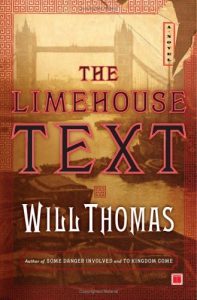 Blog Recap:
Blog Recap:










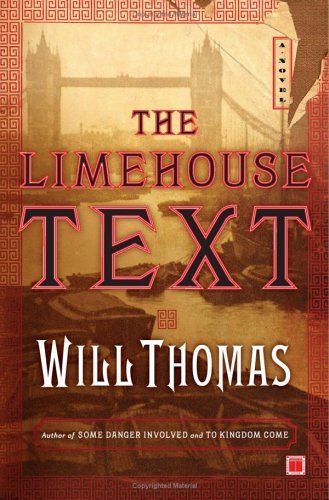 The Limehouse Text (Barker & Llewelyn, #3) by
The Limehouse Text (Barker & Llewelyn, #3) by 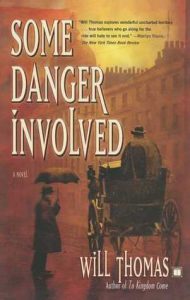 I was feeling in a bit of a murder-y mood this week – reading-wise at least. Which seems entirely fitting as we’re ‘killing’ 2023 this weekend and ringing in 2024.
I was feeling in a bit of a murder-y mood this week – reading-wise at least. Which seems entirely fitting as we’re ‘killing’ 2023 this weekend and ringing in 2024. 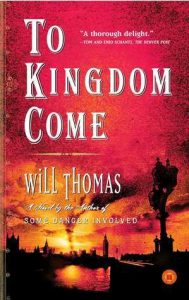 Escape Rating A+: One thing drove me utterly bananas during my reading of The Limehouse Text. I had the vague impression, not that I’d read this before, but that the Jeremy Brett Sherlock Holmes series had also tackled a story set in Limehouse – London’s Victorian version of Chinatown – but couldn’t track down precisely which story. I think it may have been
Escape Rating A+: One thing drove me utterly bananas during my reading of The Limehouse Text. I had the vague impression, not that I’d read this before, but that the Jeremy Brett Sherlock Holmes series had also tackled a story set in Limehouse – London’s Victorian version of Chinatown – but couldn’t track down precisely which story. I think it may have been 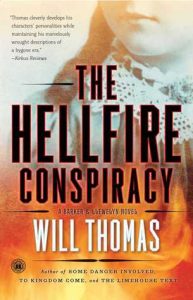 In the end, this is a clever, convoluted mystery, solved but not truly resolved by fascinating characters, steeped in a culture and a perspective that was not treated with any kind of respect in its time and about which stereotypes promoted during this period still linger. The reader is inexorably drawn in by the mystery and the setting, and left with both the satisfaction of at least some just desserts being served – as a mystery should – while still reeling from the marvelously presented microcosm of all the reasons why ‘colonialism’ is such a disgustingly dirty word in so many places around the globe to this very day.
In the end, this is a clever, convoluted mystery, solved but not truly resolved by fascinating characters, steeped in a culture and a perspective that was not treated with any kind of respect in its time and about which stereotypes promoted during this period still linger. The reader is inexorably drawn in by the mystery and the setting, and left with both the satisfaction of at least some just desserts being served – as a mystery should – while still reeling from the marvelously presented microcosm of all the reasons why ‘colonialism’ is such a disgustingly dirty word in so many places around the globe to this very day. Murder at the Serpentine Bridge (Wrexford & Sloane, #6) by
Murder at the Serpentine Bridge (Wrexford & Sloane, #6) by  As the previous book in this series,
As the previous book in this series,  Escape Rating A: This was the right book at the right time, and I clearly waited enough time after
Escape Rating A: This was the right book at the right time, and I clearly waited enough time after  Meanwhile, everyone is chasing everyone else’s tails into danger, as the government’s intelligence services are unwilling to let the right hand know what the left hand is doing (shades of yesterday’s book) and everyone is unwittingly keeping vital clues from even their nearest and dearest.
Meanwhile, everyone is chasing everyone else’s tails into danger, as the government’s intelligence services are unwilling to let the right hand know what the left hand is doing (shades of yesterday’s book) and everyone is unwittingly keeping vital clues from even their nearest and dearest.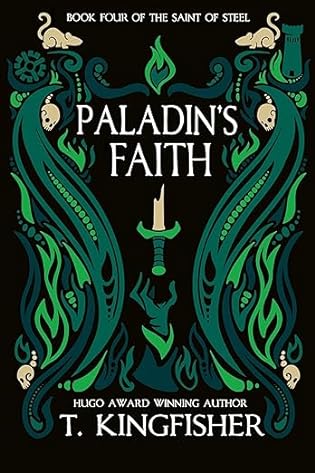 Paladin's Faith (The Saint of Steel, #4) by
Paladin's Faith (The Saint of Steel, #4) by 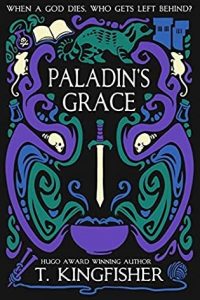 There’s a classic saying about large organizations at cross-purposes within themselves, that the right-hand doesn’t know what the left hand is doing. Marguerite Florian’s problem with the Red Sail mercantile empire is that their “right hand does not know who the left is killing”.
There’s a classic saying about large organizations at cross-purposes within themselves, that the right-hand doesn’t know what the left hand is doing. Marguerite Florian’s problem with the Red Sail mercantile empire is that their “right hand does not know who the left is killing”.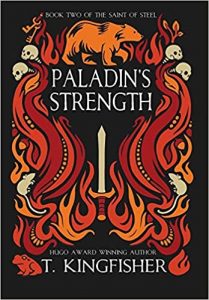 Marguerite just has to stay alive long enough to find the artificer. For that, she’ll need bodyguards who can’t be bribed or bought, seduced or suborned. She needs a paladin – or two.
Marguerite just has to stay alive long enough to find the artificer. For that, she’ll need bodyguards who can’t be bribed or bought, seduced or suborned. She needs a paladin – or two.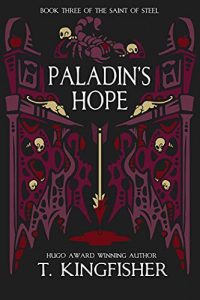 Howsomever, by the nature of that waiting game a LOT of this story is extremely interesting character development with a fair bit of adding to the depth of the worldbuilding but one does, like one of the side characters, Davith, want them to just ‘get on with it’ one way or another, either to get a move on in their mission or just make a move on each other.
Howsomever, by the nature of that waiting game a LOT of this story is extremely interesting character development with a fair bit of adding to the depth of the worldbuilding but one does, like one of the side characters, Davith, want them to just ‘get on with it’ one way or another, either to get a move on in their mission or just make a move on each other.














 Current Giveaways:
Current Giveaways: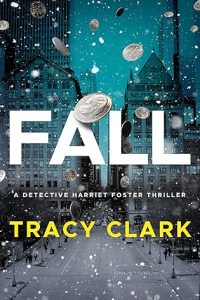 Blog Recap:
Blog Recap: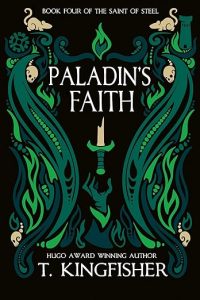 Christmas Day 2023 (Guest Post by Galen)
Christmas Day 2023 (Guest Post by Galen)









 The Butterfly Collector by
The Butterfly Collector by  Escape Rating B: I have to say that I ended up with mixed feelings all over the place while listening to and reading The Butterfly Collector. In the end, the 1922 story carried me through, but it’s the 1868 story that held the most bone-chilling horrors. Real-life horror, like revenge, is compellingly served ice cold – and the horrors of this story, based on real historical events – had plenty of chills to deliver.
Escape Rating B: I have to say that I ended up with mixed feelings all over the place while listening to and reading The Butterfly Collector. In the end, the 1922 story carried me through, but it’s the 1868 story that held the most bone-chilling horrors. Real-life horror, like revenge, is compellingly served ice cold – and the horrors of this story, based on real historical events – had plenty of chills to deliver.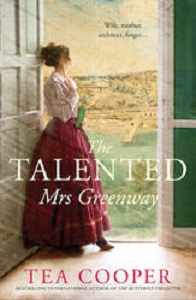 Once I switched to text it all got better, and I was able to finally be captured by the increasingly frenetic pace of the mystery of it all. Not just a terrible crime, but decades of a profitable series of terrible crimes come to light and sticks a knife into Verity’s heart AND her perceptions of her family’s history in a way that makes the whole story both sing and sting at the same time.
Once I switched to text it all got better, and I was able to finally be captured by the increasingly frenetic pace of the mystery of it all. Not just a terrible crime, but decades of a profitable series of terrible crimes come to light and sticks a knife into Verity’s heart AND her perceptions of her family’s history in a way that makes the whole story both sing and sting at the same time.